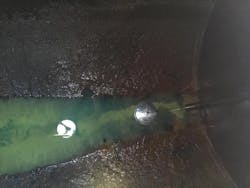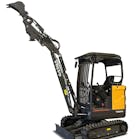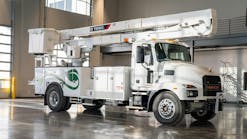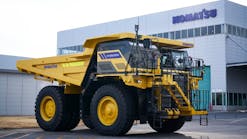That statement in Donaldson Filtration Solutions’ whitepaper, Fuel Filtration Reality Check, succinctly points out that filtering diesel fuel for use in Tier 4-Final engines is a serious issue. The microscopic tolerances in electronic fuel injectors used in high-pressure/common-rail (HP/CR) fuel systems—prevalent in Tier 4 engines and operating at pressures of 30,000 psi or more—are intolerant of even minuscule bits of dirt.
Clean Fuel Resources
- Donaldson: www.mycleandiesel.com
- Cummins: www.cumminsfiltration.com
- Baldwin: www.baldwinfilters.com
- Chevron: www.chevron.com
- Parker: www.velcon.com/clean-diesel/
- Pall: www.pall.com/mining
- Schroeder: www.schroederindustries.com
- Caterpillar: https://pdf.cat.com
- WWFC: www.acea.be
To quantify the fuel-injector’s working environment, the Southwest Research Institute introduced particulate contamination of various sizes into an HP/CR fuel system to test the effect of hard particulates on the system’s injectors. The study concluded that particles in the range of 2 to 3 microns were “of most concern for causing indentations and eventually catastrophic erosive wear in the HP/CR system.” (For size perspective, about 50 of those 2-micron particles would fit across the width of a typical grain of table salt.)
Given those statistics, manufacturers of fuel-injection systems, engines, and equipment—as well as a growing number of equipment users—are increasingly concerned that fuel being delivered to the machine owner’s bulk-storage tanks, or being wet-hosed (placed directly) into on-site machines, typically falls far short of required cleanliness levels. The problem often is compounded by the equipment owner’s poor maintenance of storage tanks.
ASTM/Worldwide Fuel Charter
The widely accepted specification in the United States for diesel-fuel characteristics—American Society for Testing and Materials (ASTM) D975—addresses fuel cleanliness only by limiting sediment and water (combined) to 500 ppm.
“At 500 ppm,” says Scott Grossbauer, director for Donaldson’s Clean Solutions Group, “you can be selling fuel that is extremely dirty and still meet the ASTM standard.”
Howard Chesneau, president of Fuel Quality Services, a fuel-additive and consulting firm, adds perspective at this point: “It’s not that diesel fuel is manufactured dirty; it’s not. But in general, our infrastructure is not clean and housekeeping at the machine owner’s level is often lacking.”
Chesneau further adds that the ASTM specification is intended to address fuel performance—“fit-for-use issues while the fuel is in commerce, prior to purchase,” he says, “and not the cleanliness of a retail jobber’s storage tanks or those of the equipment owner.”
The Worldwide Fuel Charter (WWFC), however, an organization formed in 1998 by vehicle and engine manufacturers to elevate fuel quality, does address the issue of fuel cleanliness more specifically, recommending that diesel fuel meet an ISO-4406 cleanliness code of 18/16/13.
The 5th edition of the WWFC, September 2013, summarizes: “Engine and vehicle manufacturers recommend applying the Worldwide Fuel Charter’s particulate contamination specification [18/16/13] at the fuel-station nozzle to prevent particles originating from fuel transport, storage and logistics from reaching the engine.”
(If you’re unfamiliar with the ISO—International Standards Organization—code, this might be helpful.)
According to Grossbauer, however, no manufacturer of HP/CR fuel systems or Tier 4-Final engines believes that diesel fuel even at this level of cleanliness is clean enough. Most are recommending ratings on the order of 12/9/6, which, says Grossbauer, is 64 times cleaner than 18/16/13 when counting particulates 4 microns and larger.
Diesel fuel might arrive at the machine owner’s site at an ISO code of 16 or 17 for 4-micron-and-larger particles, says Grossbauer, “which is relatively clean, but not typical. Ratings can be all the way up to a 21 from a delivery truck that hasn’t been cleaned in a while, and in remote areas, where fuel moves through more and more infrastructure, ratings higher than 22 might be seen.”
(Reducing particulates from a 22 code to a 12 code means that the average count of particles 4 microns and larger drops from 30,000 to 30 in each milliliter of fuel.)
“Part of the problem,” says Grossbauer, “is that the fuel supply in the United States is fungible, similar to placing electricity on a grid. Doesn’t make any difference who produced the power, anyone can take it off the grid and use it. Fuel refiners produce a product that meets the ASTM spec, then place it the pipeline. What’s purchased on the other end may or may not be their specific product. Refiners could invest in the most up-to-date filtration possible, but as soon as they place fuel in the pipeline, they essentially lose control—and nobody wants to sign up for anything not in their control.”
The fuel marketer’s view
Fuel marketers—those companies delivering fuel to the fleet owner’s bulk-storage tank or wet-hosing machines on the job site—look at the fuel-cleanliness issue from the other end of the pipeline. They maintain that they have fulfilled their obligation to clients by delivering a product meeting ASTM standards.
“Diesel can be contaminated at many points in the supply chain,” says Rob Underwood, president of the Petroleum Marketers Association of America (PMAA), “starting at the refinery, through a pipeline, in terminal storage tanks, in barges and ships, and in retail storage tanks. It’s unfortunate that, to date, much of the blame [for dirty fuel] has fallen on the retailing community—the final step in the supply chain—without recognizing that upstream [conditions], beyond the retailer’s control, contribute to cleanliness issues. This should be a total industry effort and shouldn’t fall just on the retailer.”
Commenting on the National Conference on Weights and Measures’ (NCWM) rejection some months ago of a proposal that would have mandated “10-micron” filtration on diesel pumps at truck stops, Underwood summarizes PMAA’s position: “As long as marketers are selling an ASTM-spec product, it is beyond NCWM’s proper authority to mandate additional filtration. It should be handled at ASTM, because it deals with diesel fuel standards and entails an examination of the entire fuel supply chain, rather than a specific segment in isolation.”
Chesneau disagrees that fuel cleanliness at the retail level is ASTM’s problem: “ASTM creates standards requested by manufacturers and stakeholders and develops tests to validate those standards,” he says. “The organization does not mandate how people get there. After fuel is produced, cleanliness falls upon others as housekeeping issues—not on ASTM. If this isn’t a consumer-protection oversight issue to be addressed by such entities as PMAA or NCWM, then who?”
The fuel-user’s view
Caught between engine manufacturers, who call for using spotlessly clean fuel in their products, and fuel marketers, who rightly insist that they are delivering a product that meets current industry standards, are equipment owners. One such is Leigh Dennis, CEM, manager of fleet services for Carolina Sunrock, Sunrock Group, a supplier of aggregate, concrete products, and contracting services.
“The fact that the technologies employed in the end-use of diesel fuel have advanced exponentially since the ASTM standards were written seems to mean nothing to ASTM, PMAA or API [American Petroleum Institute],” says Dennis. “To the representatives I’ve spoken with, ISO cleanliness standards are unknown and/or ignored. As far as they’re concerned, it’s not their problem. Essentially, as long as fuel meets the prescribed ASTM chemical and physical requirements, absolutely no one on the supply side has any incentive or initiative to do anything more than what ASTM requires.”
That said, Dennis is quick to point out that many in the fuel-using community do recognize the larger scope of the issue and the implications involved:
“From the end-user perspective, bulk diesel fuel is a subject for which some stakeholders would prefer to maintain the status quo. Diesel fuel is a commodity that commands such fear, that even the suspicion of a lack of availability ripples markets nationwide. Before I place this company at risk or jeopardize business relationships, I prefer to gauge our [fuel] vendors’ knowledge level and their willingness to partner in a solution.
“Solutions will be found only when meaningful communication among stakeholders begins. The knowledge gap between these groups is increasing at the same rate as advanced engine technologies are being employed. ISO already has the necessary standards—we work with them every day.”
Given the “status quo” that Dennis cites, Donaldson’s Grossbauer takes a pragmatic view of the situation: “We haven’t spent a lot of time trying to influence standards; that could be a decades-long process that might not be effective; so we go right to the end user.”
Protecting engines
Going to the end user, as Grossbauer says, involves managing both on-engine filtration and managing fuel between its delivery by a bulk tanker and its being dispensed into a machine.
The good news is that the cleanliness standards required by fuel-injection-system manufacturers and diesel-engine builders, strict as they might be, are attainable with today’s on-engine filtration technology.
“Whatever the engine manufacturer or fuel-system manufacturer says about their required cleanliness is the gospel,” says Grossbauer. “We can’t challenge that; we have to hit their targets with on-engine filters.”
Accomplishing that, however, is not without difficulty.
“We’re capable of achieving those standards,” says Grossbauer. “Testing has shown that we’re actually—at least in the lab—down in the single digits [of the ISO code], well below 12/9/6. The challenge becomes hitting that target under real-world conditions—in the presence of vibration, fluctuating flow, and all the factors that make filtration difficult. But the filtration industry has met those challenges.”
Added to the difficulty of filtration efficiency, though, is the real-world challenge of space; equipment manufacturers do not have unlimited under-hood room to accommodate filtration.
“Unless you can make filters two or three times larger than they are today,” says Grossbauer, “they’re going to be sensitive to any incoming dirt. You can’t always have it both ways, that is, high efficiency to meet cleanliness specs and the length of filter life machine owners once expected—all in the same filter.”
Compounding the problem of short filter life (and the possible cause of injector deposits resulting in over-fueling if they reach injectors) are various organic substances, which are not dirt, says Grossbauer, but are related, perhaps, to such sources as glycerin in bio-fuel blends or performance additives—corrosion inhibitors, lubricity improvers and the like. “All things that need to be in there,” he says, “but if not placed in the fuel under the right conditions, then they essenentially don’t get dissolved and can be trapped with filtration fine enough.”
Whatever the cause of short filter life, engine manufacturers are not sympathetic: “Manufacturers know exactly what they need to protect their engines,” says Fuel Quality Services’ Chesneau, “and they couldn’t care less if filters are changed every day. In fact, I’ve seen presentations by injector manufacturers claiming that the present specifications for filters used on Tier-4 engines, as tight as they are, still might not be sufficient to protect injectors from early failure.”
The take-away here seems to be that if you’re not using specified OEM on-engine filters, then due diligence is required to evaluate the specifications of the filters you’re buying against those of the OEM. The experts say that a filter’s Beta Ratio for specific particle sizes and the filter’s efficiency rating, based on the Beta Ratio, are the most objective measures of comparison—more objective than relying on a “nominal” or “absolute” micron rating.
Recognizing the critical issue of on-engine filtration, some machine owners have installed supplemental filtration systems and some have switched to premium filters that use advanced synthetic media and possibly exceed OEM requirements, reasoning that the best filters are the cheapest engine insurance at any cost.
Preventive maintenance practices:
(The Machinery Lubrication website has a detailed discussion of the Beta Ratio and filter efficiency.)
Practical steps
“Actually, filtration should not focus on the equipment,” says Chesneau, “but on getting control of fuel before it’s pumped into equipment. Why would you put dirty fuel into your equipment and require your on-board filters to do the heavy lifting?”
For fuel that is received in bulk at the machine owner’s location, Donaldson recommends a “clean/protect/polish” strategy. Grossbauer explains: “Filter fuel on the way in, protect it in the tank with a good breather having water-absorbent technology, and then filter it again when dispensing into a machine to catch any chemistry issues or debris picked up in the tank.
“The place to start is to check the cleanliness of fuel presently being dispensed into machines. How dirty is it? Is there water present? This analysis gives a snapshot of what’s going into the equipment. If the results are not good, the next step might be to take a sample at the bottom of the storage tank and flush the tank if required.”
Sunrock’s strategy at present, says Dennis, is to filter fuel dispensed into machines, using Donaldson 4-micron, spin-on filters with a 10-micron filter upstream. Without the upstream filter, he says, 4-micron filter life is unacceptable, in his opinion, at a 50-gpm flow rate. Tank maintenance involves testing at three-month intervals, drawing off contaminants every six months, and inspecting and cleaning (if required) annually.
So far, Sunrock has not installed filtration on the bulk-tank inlet: “If we were to install inlet filters, they would clog at an unknown rate and result in unplanned fuel-system down time,” says Dennis. “There are good loads [of fuel] and bad loads. The point at which the filters might have to be changed could happen at any time during any delivery. I’ve asked my suppliers to partner in finding a solution before investing in inlet filtration.”
Dennis also is convinced that the off-highway diesel fuel Sunrock receives has more contamination than on-road fuel, despite supplier assurances that the only difference is “dye and taxes.” His gauge for the opinion is dispensing-filter life, which is dramatically shorter for the off-road tank. Donaldson’s Grossbauer suggests that perhaps fuel in off-road markets tends to be exposed to (and collect) more contamination.
The discussion essentially returns to delivered-fuel cleanliness and the challenges of filtering incoming fuel. Dennis sums up the issue:
“Machine operational readiness and the value of extended warranties suffer terribly from not getting this [fuel cleanliness] under control at the point of delivery. Filters are cheap by comparison, so introduce filtration at every transfer point and save not just a little bit of money, save a lot of money. For the end user, the last frontier in fuel management is that of incoming bulk- fuel filtration, and to manage it properly, we have to educate our suppliers.”
Questions about the cleanliness of fuel wet-hosed into machines must remain for another day. In the meantime, Fuel Quality Services’ Chesneau has sound advice: “Don’t try to save nickels as you jump over dollars. With Tier-4 equipment, that mentality will get very expensive faster than you think.





